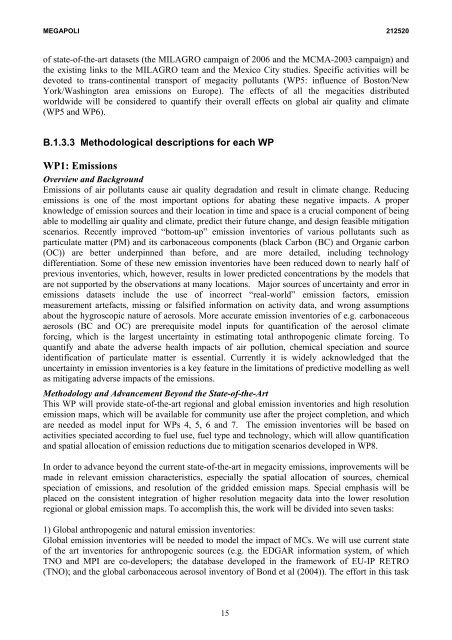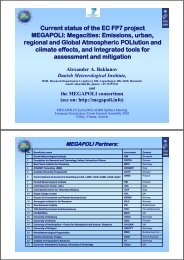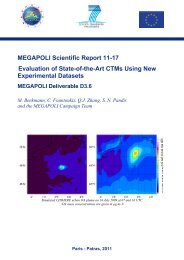D E S C R I P T I O N O F W O R K - MEGAPOLI - Dmi
D E S C R I P T I O N O F W O R K - MEGAPOLI - Dmi
D E S C R I P T I O N O F W O R K - MEGAPOLI - Dmi
You also want an ePaper? Increase the reach of your titles
YUMPU automatically turns print PDFs into web optimized ePapers that Google loves.
<strong>MEGAPOLI</strong> 212520<br />
of state-of-the-art datasets (the MILAGRO campaign of 2006 and the MCMA-2003 campaign) and<br />
the existing links to the MILAGRO team and the Mexico City studies. Specific activities will be<br />
devoted to trans-continental transport of megacity pollutants (WP5: influence of Boston/New<br />
York/Washington area emissions on Europe). The effects of all the megacities distributed<br />
worldwide will be considered to quantify their overall effects on global air quality and climate<br />
(WP5 and WP6).<br />
B.1.3.3 Methodological descriptions for each WP<br />
WP1: Emissions<br />
Overview and Background<br />
Emissions of air pollutants cause air quality degradation and result in climate change. Reducing<br />
emissions is one of the most important options for abating these negative impacts. A proper<br />
knowledge of emission sources and their location in time and space is a crucial component of being<br />
able to modelling air quality and climate, predict their future change, and design feasible mitigation<br />
scenarios. Recently improved “bottom-up” emission inventories of various pollutants such as<br />
particulate matter (PM) and its carbonaceous components (black Carbon (BC) and Organic carbon<br />
(OC)) are better underpinned than before, and are more detailed, including technology<br />
differentiation. Some of these new emission inventories have been reduced down to nearly half of<br />
previous inventories, which, however, results in lower predicted concentrations by the models that<br />
are not supported by the observations at many locations. Major sources of uncertainty and error in<br />
emissions datasets include the use of incorrect “real-world” emission factors, emission<br />
measurement artefacts, missing or falsified information on activity data, and wrong assumptions<br />
about the hygroscopic nature of aerosols. More accurate emission inventories of e.g. carbonaceous<br />
aerosols (BC and OC) are prerequisite model inputs for quantification of the aerosol climate<br />
forcing, which is the largest uncertainty in estimating total anthropogenic climate forcing. To<br />
quantify and abate the adverse health impacts of air pollution, chemical speciation and source<br />
identification of particulate matter is essential. Currently it is widely acknowledged that the<br />
uncertainty in emission inventories is a key feature in the limitations of predictive modelling as well<br />
as mitigating adverse impacts of the emissions.<br />
Methodology and Advancement Beyond the State-of-the-Art<br />
This WP will provide state-of-the-art regional and global emission inventories and high resolution<br />
emission maps, which will be available for community use after the project completion, and which<br />
are needed as model input for WPs 4, 5, 6 and 7. The emission inventories will be based on<br />
activities speciated according to fuel use, fuel type and technology, which will allow quantification<br />
and spatial allocation of emission reductions due to mitigation scenarios developed in WP8.<br />
In order to advance beyond the current state-of-the-art in megacity emissions, improvements will be<br />
made in relevant emission characteristics, especially the spatial allocation of sources, chemical<br />
speciation of emissions, and resolution of the gridded emission maps. Special emphasis will be<br />
placed on the consistent integration of higher resolution megacity data into the lower resolution<br />
regional or global emission maps. To accomplish this, the work will be divided into seven tasks:<br />
1) Global anthropogenic and natural emission inventories:<br />
Global emission inventories will be needed to model the impact of MCs. We will use current state<br />
of the art inventories for anthropogenic sources (e.g. the EDGAR information system, of which<br />
TNO and MPI are co-developers; the database developed in the framework of EU-IP RETRO<br />
(TNO); and the global carbonaceous aerosol inventory of Bond et al (2004)). The effort in this task<br />
15




